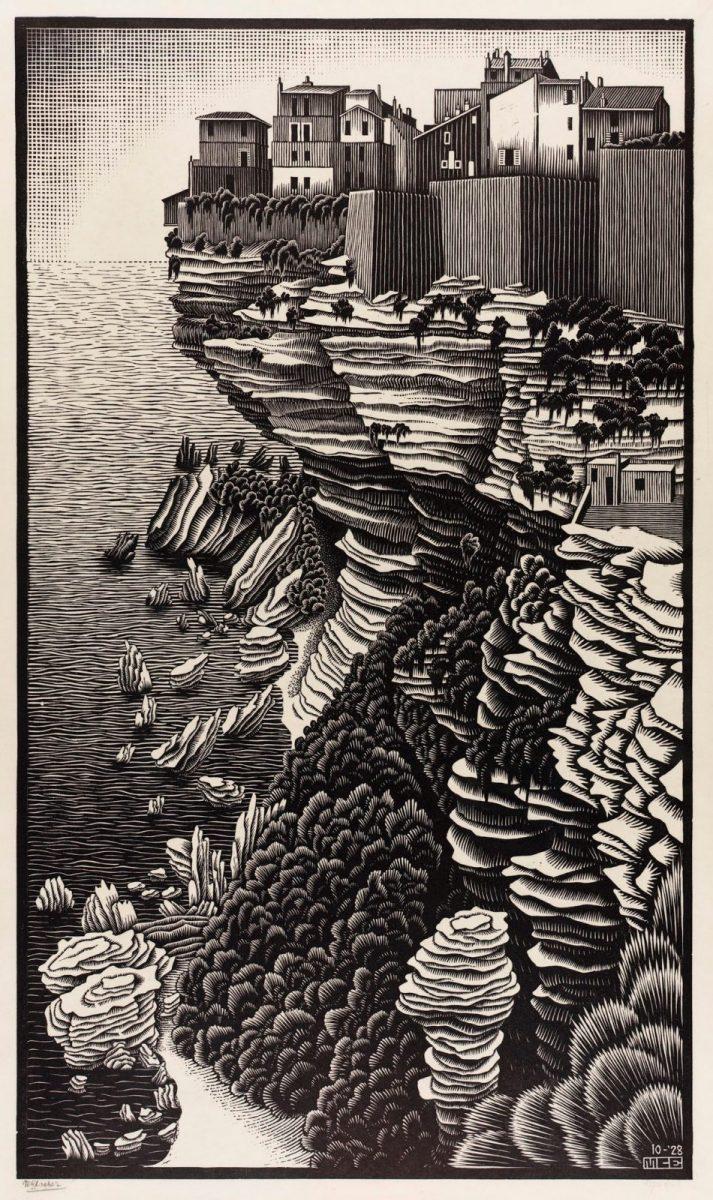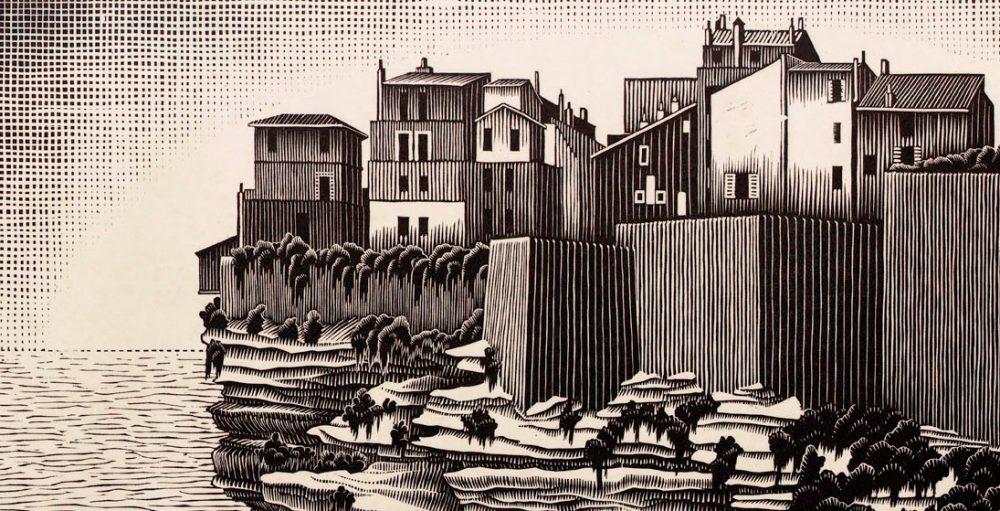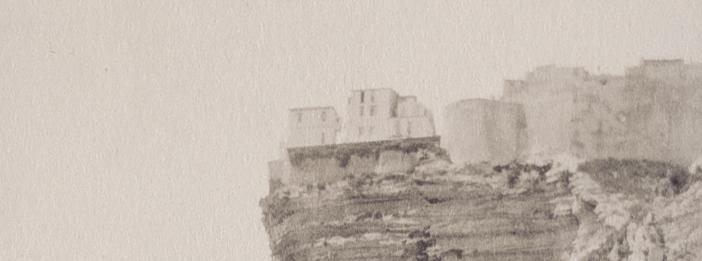

"During my wanderings, everything around me seems real. But later, when I reconstruct the images in my mind's eye, I realise that it was like a dream; when I think back now to what I encountered in Corsica that spring, I recall a vivid sound, a smell, a mood and I am overwhelmed by emotion."
These words were penned by Escher in 1928 to his lifelong friend Bas Kist, whom he met at school and who subsequently became a lawyer in Amsterdam. In June 1928, Escher travelled to the French island with his father-in-law Arturo Umiker. In customary fashion, Escher made drawings of this journey for prints he would create later in the year. In October 1928 this resulted in the woodcut Bonifacio.

It is a remarkable print. Just as in the lithograph Castrovalva, which Escher made a year later, this work evokes a sense of movement that is not immediately apparent. The first thing the viewer notices about Bonifacio is the enormous rock formation that takes up almost two thirds of what to all intents and purposes is a small print. Above the rock formation we can see fortification walls and houses: the small town of Bonifacio. The residents had built their dwellings high on the hilltop to defend themselves against sea attacks by the Saracens.
When we look at the print, it is as though we are standing next to the artist on the very edge of a cliff. The houses of Bonifacio are slightly above us. In this print, unlike in Castrovalva, your eyes do not make a circular journey. Instead, you sense that you are staring straight into the abyss. Your attention is drawn to the curly strip of white sand at the bottom the rocks and before you know it, you are gazing upon the sea. Next, your gaze is once again directed upward via the sea stacks and the groves clinging to the cliff's edge to the small bushes below the town. From there, as you look to the left, you once again see the fortification wall and the houses of Bonifacio. Almost simultaneously, your eyes are drawn to the horizon to the left of the town. Even though, like the town, the horizon is at eye level, you intuitively know that the horizon is much further away. The town and the skyline are virtually at the same level, and yet the town is much closer to us than the horizon. Escher uses a clever technique to depict the distance between Bonifacio - perched on a rock high above the sea - and the horizon, he positions the houses in a semi-circular lightened plane. To achieve this effect, Escher used a gouge to cut away the areas around the town. (Woodcutting is a form of relief printing, that is to say that everything that remains takes on the colour of the ink and everything that is cut or gouged out of the wood does not come into contact with the ink when printed by hand. These parts remain white, provided of course you use white paper).

The rest of the skyline consists of tiny irregular square patterns, which he printed in varying degrees of intensity. Consequently, some sections are blacker than others. This creates a natural line-of-sight to the horizon and the impression of depth. The horizon is formed by short, angular lines, and the sea consists of longer lines that vary not only in length, but also in thickness. The bright light of the Mediterranean Sea reflects onto the houses. At first glance they appear to be the reflections of the sea, rather than houses drenched in the full glare of the sun.
There are striking similarities and notable differences between Escher's print of 1928 and the reality depicted in the photos taken in 2006. Of course, we need to bear in mind that Escher always based his prints on his drawings. It appears that the photo of 2006 was taken from the same elevated vantage point as that chosen by Escher for his main studies for Bonifacio, namely on another high rock opposite the town. Escher makes the wall more angular and if you look closely, you will see that - as in Castrovalva - the print contrasts with reality in the way it depicts the row of houses. Some of the changes will have been made by the residents over the past 80 years, while others are clearly conscious choices made by Escher in his endeavour to create a good work of art. (I've also added a detail from the photo of 1928, which has been taken from an entirely different vantage point, namely on the beach at the foot of the rocks. Although this creates a different perspective, it bears many similarities).


Escher created a work of art that takes reality as a guiding principle, rather than as the ultimate and only benchmark. It never ceases to amaze me how his interpretation manages to capture the essence of the subject matter more vividly, than had he pursued a meticulously accurate representation of reality. The lady who took the photograph in 2006 is a good friend of mine. She instantly saw - and continues to see - the similarities between reality and the print.
When we compare the photo with the print, we see other differences. The photo is of course wider than the print, which means that the focal point is the horizon line rather than the depth of the sea. A photo is more clear-cut than a print, in which the artist consciously guides your eyes and dictates where you look. In addition, the zigzag transition from extreme depth to the extreme height of the houses and the distant horizon is absent from the photograph. Even if this photo were cropped to create the same narrow field of vision, the sense of depth would still be given less prominence than in Escher's work. He clearly exaggerated the ‘waistline’ of the cliff on which the town is perched. He needed to do this to direct our gaze upward from the depth of the sea to the town. He emphasised the horizontal layers in the limestone and made the sea closest to the rocks much darker to exaggerate the contrast with the white rocks. Despite all these differences, our first impression is: ‘wow it's still the same’.
Escher very cleverly plays with our perceptions. Incidentally, I believe this occurred naturally during the creative process. It's not something that Escher consciously thinks about. Escher very cunningly transforms his memories into a work of art. The part of the sea closest to the horizon has been cut away from the wood and is therefore predominantly white, interspersed here and there with a black wave. Conversely, the sea nearest to the rocks consists of a sporadic white wave against a black backdrop. In this case, the waves have been cut out! It all happens so gradually and naturally, that it also took me a long time to put this transition into words.
There are two noteworthy aspects of Bonifacio that become more evident in Escher's later works: firstly, he reveals only the essence, the most important elements of this special place and secondly, almost inconspicuously, he allows us to experience movement, as though we are watching a short film rather than a woodcut. This movement has not yet been perfected, but you can sense how Escher is experimenting, exploring. It is highly likely that he has not yet turned his attentions to impossible movements. Anyone who, like us, is able to look back at Escher's development, will see that his works are linked by a series of intermediate steps that eventually lead to his experiments with perpetual motion. Gradually, he begins to focus on never-ending cycles of visual impossibility, the Möbius Strip and even more complex compositions such as in Waterfall, Ascending and Descending, and Print Gallery. If Escher had not made his earlier prints such as Bonifacio and Castrovalva, in which he manipulates the Italian landscape, his later works of art would never have seen the light of day.
The Escher Archives in Kunstmuseum Den Haag contain photo albums dating back to the time that the Eschers resided in Italy. Interestingly, the photo he took of his father-in-law and Bonifacio during his travels in 1928 reveals a completely different clifftop town to the one he printed a few months later.

In 1933, Escher paid another visit to Corsica and to the town of Bonifacio. On this occasion, he was accompanied by two friends, the Swiss painters Josef Giuseppe Haas Triverio and Roberto Schiess. After this tour, he made no more prints of Bonifacio.
More stories about Escher



